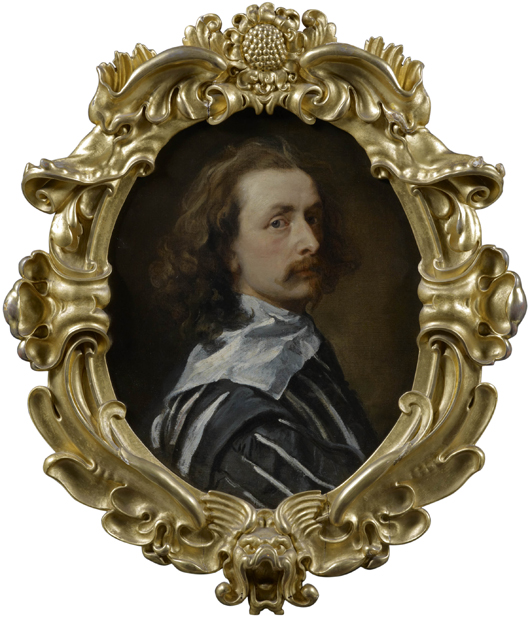MARGATE, UK – The National Portrait Gallery’s recently acquired self-portrait of Sir Anthony van Dyck was today displayed at Turner Contemporary, Margate, the first venue in its nationwide tour. It is set to be one of the star attractions of the Kent gallery’s new exhibition Self: Image and identity – self-portraiture from Van Dyck to Louise Bourgeois which opens to visitors on Saturday, January 24, 2015.
The portrait will be on public view for the first time since August 2014 when it was on display at the National Portrait Gallery prior to a period of conservation which is detailed in specially commissioned films on the Gallery’s website www.npg.org.uk/vandyck.
The Gallery is lending the portrait as part of a nationwide tour Van Dyck: A Masterpiece for Everyone which after Turner Contemporary, Margate (January 24-May 10, 2015) continues to Manchester Art Gallery in May; followed by Dulwich Picture Gallery and Birmingham Museum & Art Gallery in 2016; and Laing Art Gallery, Newcastle-upon-Tyne and the Scottish National Portrait Gallery, Edinburgh in 2017. The tour is supported by the Art Fund and Heritage Lottery Fund.
The three-year tour of the painting will also include themed displays at the National Portrait Gallery when the portrait returns to London in between periods of display at the six museums and galleries throughout Britain. In London, visitors will be able to see Sir Anthony van Dyck’s last Self-portrait in three displays which highlight the work’s importance in the context of five centuries of portrait painting from the 1550s to today.
In the first display at the National Portrait Gallery from September 2015, the work will be shown alongside paintings by van Dyck of his friends and patrons, from the Gallery’s Collection, as well as portraits by other artists at the court of Charles I. On returning to the Gallery in 2016 it will be shown alongside some of the great self-portraits of all periods from the Collection and in 2017 a third display at the Gallery will feature the portrait in the context of work by living artists.
The displays are intended to show how the new acquisition enriches the Gallery’s present holding of three works by van Dyck but also how it makes a significant addition to the National Portrait Gallery’s striking collection of self-portraits. These include works by Reynolds, Zoffany and Stubbs and, amongst twentieth-century and contemporary artists, Gwen John, Barbara Hepworth, Frank Auerbach, L S Lowry, Julian Opie, Gillian Wearing, Chris Ofili, Lucian Freud and David Hockney.
Van Dyck’s last Self-portrait (1640-1) was acquired by the National Portrait Gallery through a major fundraising appeal with the Art Fund, and with thanks to a major grant of £6,343,500 from the Heritage Lottery Fund (HLF), on 1 May 2014. It is one of three known self-portraits painted by van Dyck when he was in England, and it probably dates from the last years of his life. The artist shows himself fashionably dressed but apparently in the act of painting, the line of his right shoulder and sleeve suggesting his hand raised in the process of applying paint to a canvas just out of sight. The broad handling of the paint in the costume, compared with the face, may indicate that this area of the painting is unfinished, or it may be that this is simply a more experimental work than his formal court portraits. The frame of this painting, crested with the sunflower motif associated with the artist, is of outstanding importance and is likely to have been designed with van Dyck’s involvement.
Born in Antwerp in 1599, Anthony van Dyck was an artistic prodigy who worked as an assistant to Peter Paul Rubens. He came to Britain in 1632 at the invitation of King Charles I, making London his home until his death in 1641. Charles I was van Dyck’s most famous patron, rewarding him with a knighthood and the title of Principal Painter. Van Dyck established himself at the heart of the English court, producing magnificent portraits of the royal family and many courtiers. However, beneath the shimmering surface of the court was a sense of growing unease. The late 1630s were a time of political upheaval and by the end of 1642 civil war had broken out in Scotland and England. Within a year of producing this portrait van Dyck was dead, buried in Old St Paul’s Cathedral with the epitaph: ‘Anthony Van Dyck – who, while he lived, gave to many immortal life.’
PUBLICATION:
A new booklet on the Van Dyck Self-portrait to coincide with the tour is available from the National Portrait Gallery Shops, online (npg.org.uk/shop) and at the tour venues for £5 (paperback). There is also a full range of products supporting the tour available.


